Project Management: Flood Management in Construction Industries Report
VerifiedAdded on 2022/11/24
|11
|2165
|75
Project
AI Summary
This project delves into the critical topic of flood management within the construction industry. It begins by identifying the problem, emphasizing the need for flood-resilient construction methods and technologies, particularly in flood-prone areas. The research methodology employed is secondary research, utilizing existing data from various sources such as research reports, public libraries, and government agencies. The project then explores feasibility studies, examining government policies and the importance of designing new buildings to withstand floodwaters and minimize re-occupation time. It outlines different approaches, including flood avoidance, resistance, and repairable measures, along with water exclusion strategies. The project documents the process, detailing cost, resources, and personnel involved, and presents a Gantt chart to visualize the project timeline. It also discusses various project management techniques like cost estimation, budgeting, and performance measurement. The core of the project focuses on potential project management solutions, particularly the Critical Path Method (CPM), justifying its use and demonstrating its effectiveness through performance review, showing a reduction in the project's completion time by one day. The project concludes by highlighting the advantages of CPM in graphical representation and time-saving, providing a comprehensive analysis of flood management strategies in the construction industry.
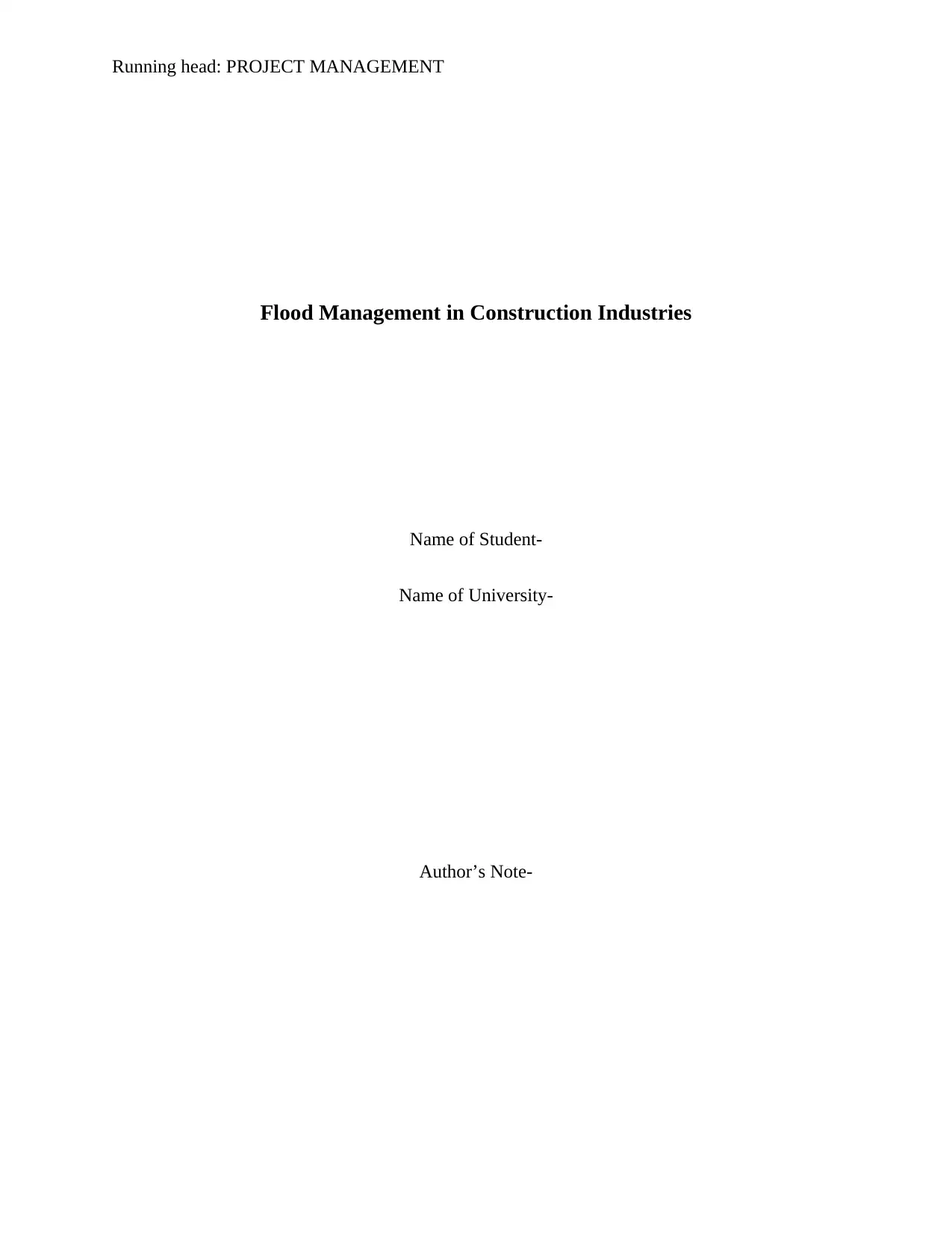
Running head: PROJECT MANAGEMENT
Flood Management in Construction Industries
Name of Student-
Name of University-
Author’s Note-
Flood Management in Construction Industries
Name of Student-
Name of University-
Author’s Note-
Paraphrase This Document
Need a fresh take? Get an instant paraphrase of this document with our AI Paraphraser
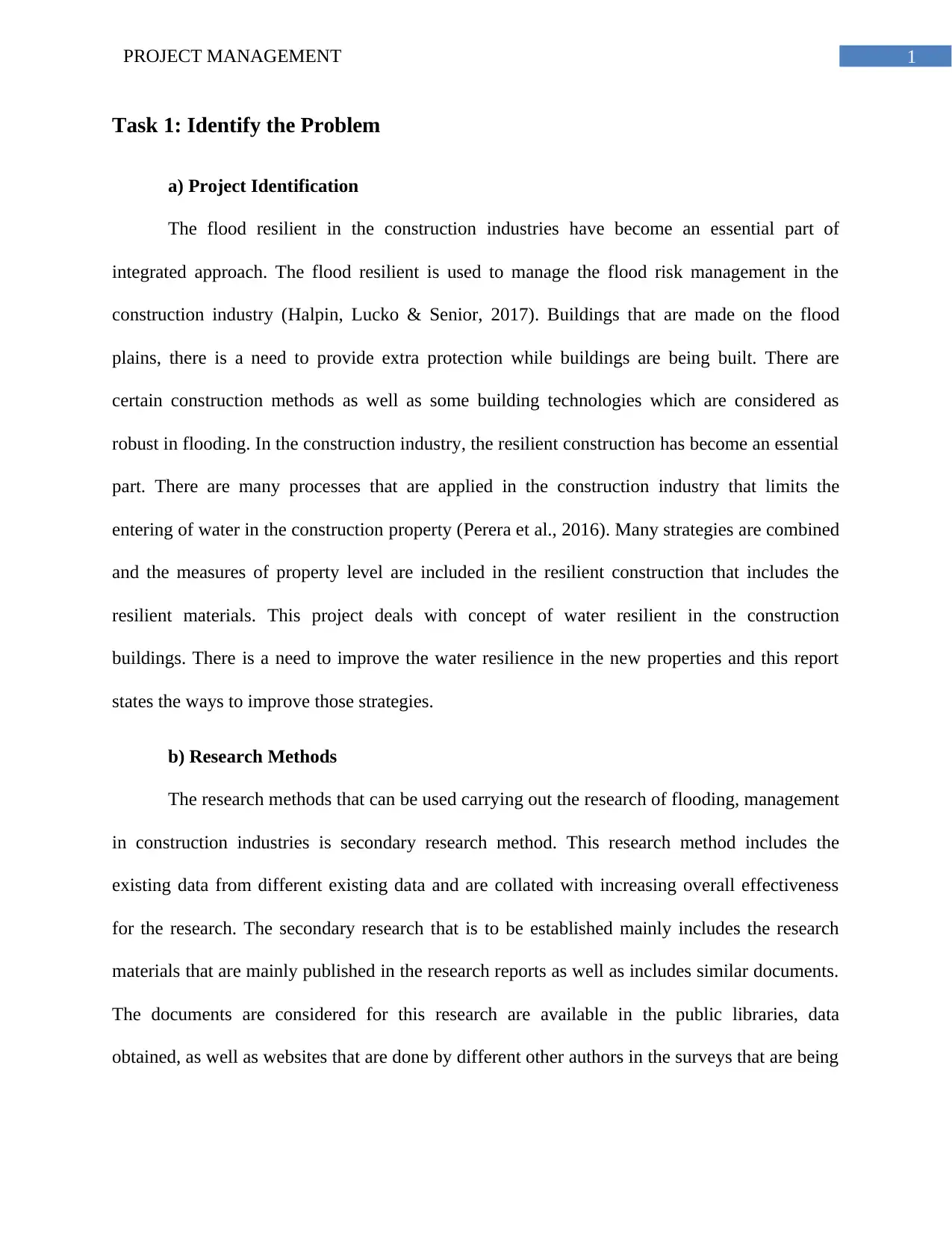
1PROJECT MANAGEMENT
Task 1: Identify the Problem
a) Project Identification
The flood resilient in the construction industries have become an essential part of
integrated approach. The flood resilient is used to manage the flood risk management in the
construction industry (Halpin, Lucko & Senior, 2017). Buildings that are made on the flood
plains, there is a need to provide extra protection while buildings are being built. There are
certain construction methods as well as some building technologies which are considered as
robust in flooding. In the construction industry, the resilient construction has become an essential
part. There are many processes that are applied in the construction industry that limits the
entering of water in the construction property (Perera et al., 2016). Many strategies are combined
and the measures of property level are included in the resilient construction that includes the
resilient materials. This project deals with concept of water resilient in the construction
buildings. There is a need to improve the water resilience in the new properties and this report
states the ways to improve those strategies.
b) Research Methods
The research methods that can be used carrying out the research of flooding, management
in construction industries is secondary research method. This research method includes the
existing data from different existing data and are collated with increasing overall effectiveness
for the research. The secondary research that is to be established mainly includes the research
materials that are mainly published in the research reports as well as includes similar documents.
The documents are considered for this research are available in the public libraries, data
obtained, as well as websites that are done by different other authors in the surveys that are being
Task 1: Identify the Problem
a) Project Identification
The flood resilient in the construction industries have become an essential part of
integrated approach. The flood resilient is used to manage the flood risk management in the
construction industry (Halpin, Lucko & Senior, 2017). Buildings that are made on the flood
plains, there is a need to provide extra protection while buildings are being built. There are
certain construction methods as well as some building technologies which are considered as
robust in flooding. In the construction industry, the resilient construction has become an essential
part. There are many processes that are applied in the construction industry that limits the
entering of water in the construction property (Perera et al., 2016). Many strategies are combined
and the measures of property level are included in the resilient construction that includes the
resilient materials. This project deals with concept of water resilient in the construction
buildings. There is a need to improve the water resilience in the new properties and this report
states the ways to improve those strategies.
b) Research Methods
The research methods that can be used carrying out the research of flooding, management
in construction industries is secondary research method. This research method includes the
existing data from different existing data and are collated with increasing overall effectiveness
for the research. The secondary research that is to be established mainly includes the research
materials that are mainly published in the research reports as well as includes similar documents.
The documents are considered for this research are available in the public libraries, data
obtained, as well as websites that are done by different other authors in the surveys that are being
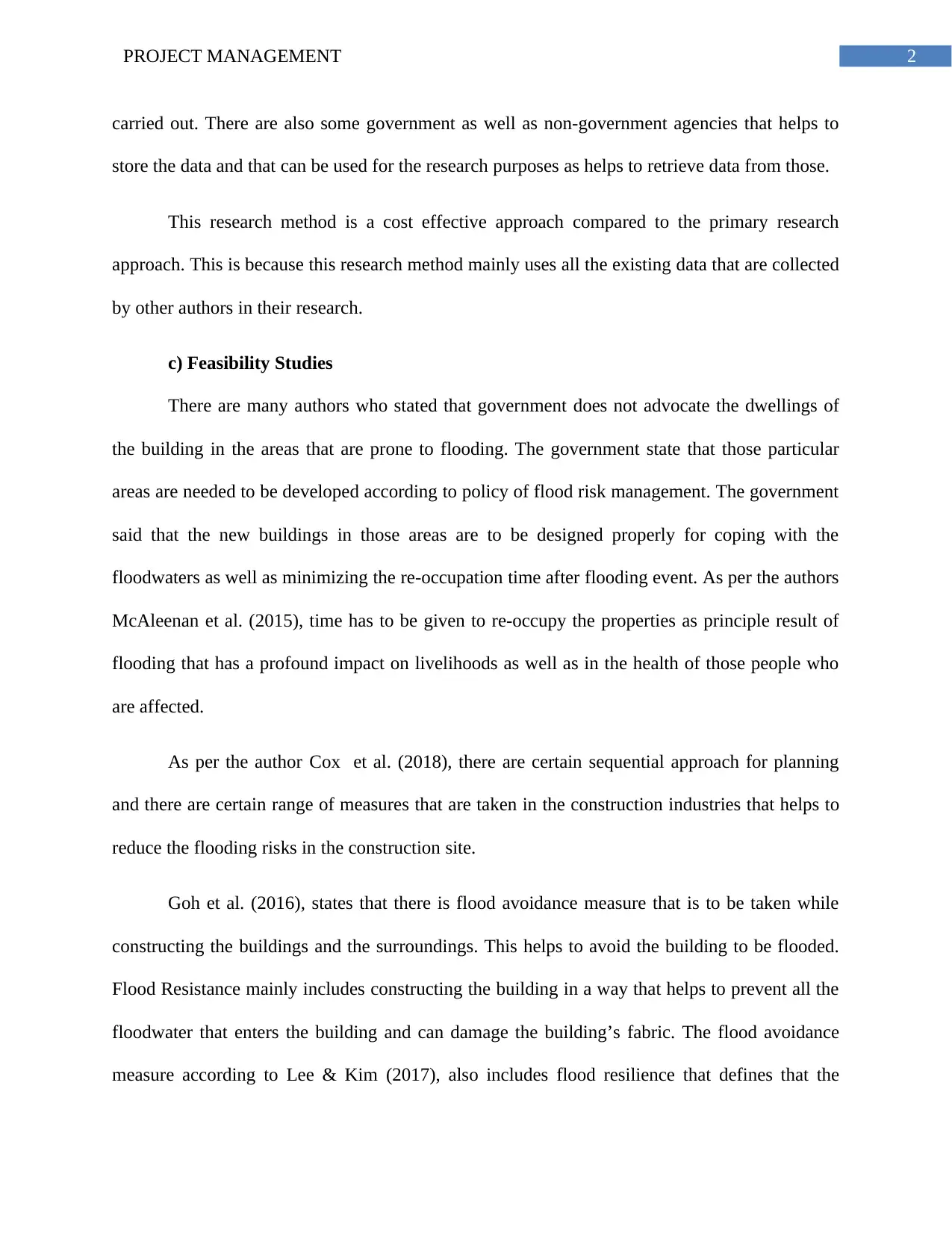
2PROJECT MANAGEMENT
carried out. There are also some government as well as non-government agencies that helps to
store the data and that can be used for the research purposes as helps to retrieve data from those.
This research method is a cost effective approach compared to the primary research
approach. This is because this research method mainly uses all the existing data that are collected
by other authors in their research.
c) Feasibility Studies
There are many authors who stated that government does not advocate the dwellings of
the building in the areas that are prone to flooding. The government state that those particular
areas are needed to be developed according to policy of flood risk management. The government
said that the new buildings in those areas are to be designed properly for coping with the
floodwaters as well as minimizing the re-occupation time after flooding event. As per the authors
McAleenan et al. (2015), time has to be given to re-occupy the properties as principle result of
flooding that has a profound impact on livelihoods as well as in the health of those people who
are affected.
As per the author Cox et al. (2018), there are certain sequential approach for planning
and there are certain range of measures that are taken in the construction industries that helps to
reduce the flooding risks in the construction site.
Goh et al. (2016), states that there is flood avoidance measure that is to be taken while
constructing the buildings and the surroundings. This helps to avoid the building to be flooded.
Flood Resistance mainly includes constructing the building in a way that helps to prevent all the
floodwater that enters the building and can damage the building’s fabric. The flood avoidance
measure according to Lee & Kim (2017), also includes flood resilience that defines that the
carried out. There are also some government as well as non-government agencies that helps to
store the data and that can be used for the research purposes as helps to retrieve data from those.
This research method is a cost effective approach compared to the primary research
approach. This is because this research method mainly uses all the existing data that are collected
by other authors in their research.
c) Feasibility Studies
There are many authors who stated that government does not advocate the dwellings of
the building in the areas that are prone to flooding. The government state that those particular
areas are needed to be developed according to policy of flood risk management. The government
said that the new buildings in those areas are to be designed properly for coping with the
floodwaters as well as minimizing the re-occupation time after flooding event. As per the authors
McAleenan et al. (2015), time has to be given to re-occupy the properties as principle result of
flooding that has a profound impact on livelihoods as well as in the health of those people who
are affected.
As per the author Cox et al. (2018), there are certain sequential approach for planning
and there are certain range of measures that are taken in the construction industries that helps to
reduce the flooding risks in the construction site.
Goh et al. (2016), states that there is flood avoidance measure that is to be taken while
constructing the buildings and the surroundings. This helps to avoid the building to be flooded.
Flood Resistance mainly includes constructing the building in a way that helps to prevent all the
floodwater that enters the building and can damage the building’s fabric. The flood avoidance
measure according to Lee & Kim (2017), also includes flood resilience that defines that the
⊘ This is a preview!⊘
Do you want full access?
Subscribe today to unlock all pages.

Trusted by 1+ million students worldwide
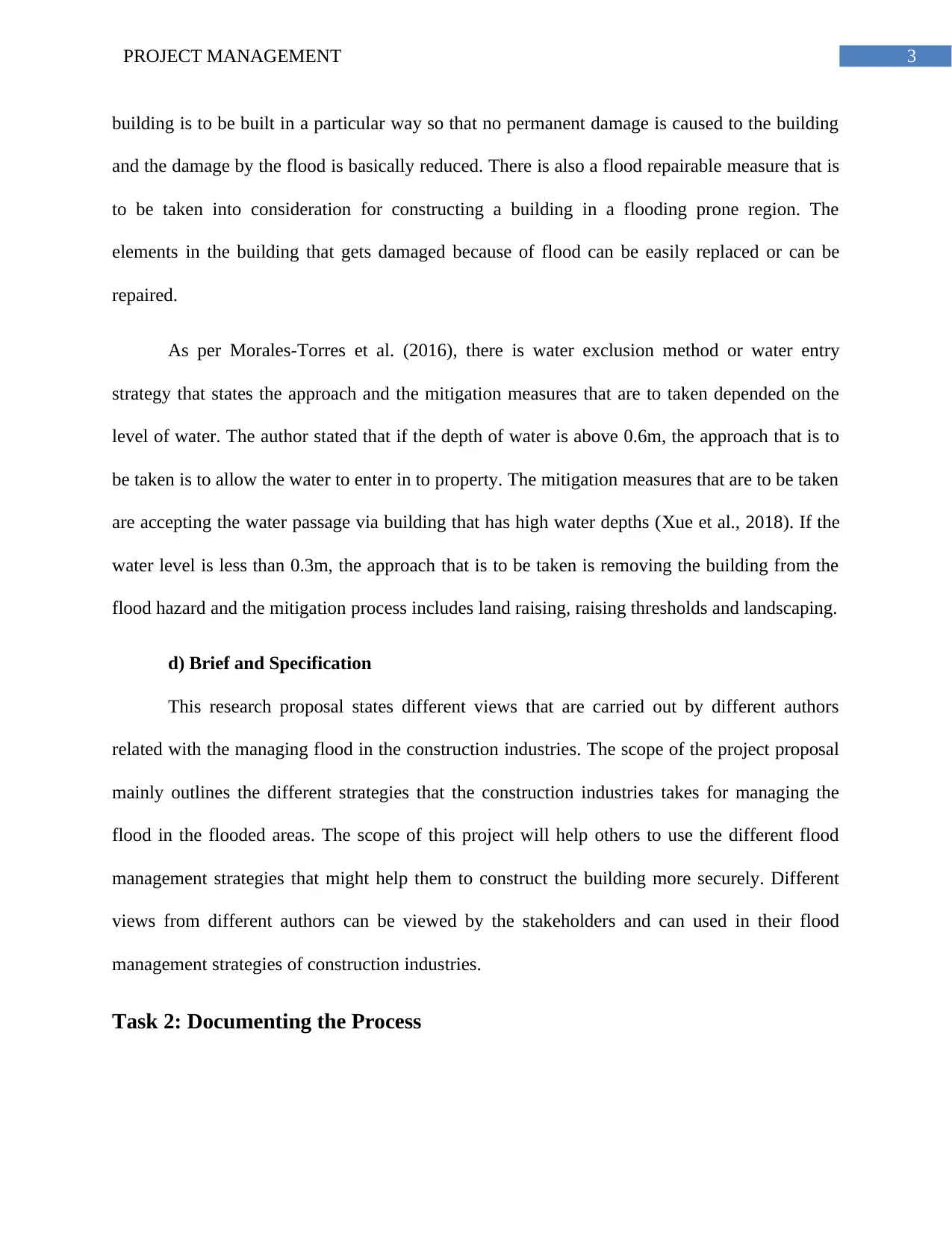
3PROJECT MANAGEMENT
building is to be built in a particular way so that no permanent damage is caused to the building
and the damage by the flood is basically reduced. There is also a flood repairable measure that is
to be taken into consideration for constructing a building in a flooding prone region. The
elements in the building that gets damaged because of flood can be easily replaced or can be
repaired.
As per Morales-Torres et al. (2016), there is water exclusion method or water entry
strategy that states the approach and the mitigation measures that are to taken depended on the
level of water. The author stated that if the depth of water is above 0.6m, the approach that is to
be taken is to allow the water to enter in to property. The mitigation measures that are to be taken
are accepting the water passage via building that has high water depths (Xue et al., 2018). If the
water level is less than 0.3m, the approach that is to be taken is removing the building from the
flood hazard and the mitigation process includes land raising, raising thresholds and landscaping.
d) Brief and Specification
This research proposal states different views that are carried out by different authors
related with the managing flood in the construction industries. The scope of the project proposal
mainly outlines the different strategies that the construction industries takes for managing the
flood in the flooded areas. The scope of this project will help others to use the different flood
management strategies that might help them to construct the building more securely. Different
views from different authors can be viewed by the stakeholders and can used in their flood
management strategies of construction industries.
Task 2: Documenting the Process
building is to be built in a particular way so that no permanent damage is caused to the building
and the damage by the flood is basically reduced. There is also a flood repairable measure that is
to be taken into consideration for constructing a building in a flooding prone region. The
elements in the building that gets damaged because of flood can be easily replaced or can be
repaired.
As per Morales-Torres et al. (2016), there is water exclusion method or water entry
strategy that states the approach and the mitigation measures that are to taken depended on the
level of water. The author stated that if the depth of water is above 0.6m, the approach that is to
be taken is to allow the water to enter in to property. The mitigation measures that are to be taken
are accepting the water passage via building that has high water depths (Xue et al., 2018). If the
water level is less than 0.3m, the approach that is to be taken is removing the building from the
flood hazard and the mitigation process includes land raising, raising thresholds and landscaping.
d) Brief and Specification
This research proposal states different views that are carried out by different authors
related with the managing flood in the construction industries. The scope of the project proposal
mainly outlines the different strategies that the construction industries takes for managing the
flood in the flooded areas. The scope of this project will help others to use the different flood
management strategies that might help them to construct the building more securely. Different
views from different authors can be viewed by the stakeholders and can used in their flood
management strategies of construction industries.
Task 2: Documenting the Process
Paraphrase This Document
Need a fresh take? Get an instant paraphrase of this document with our AI Paraphraser
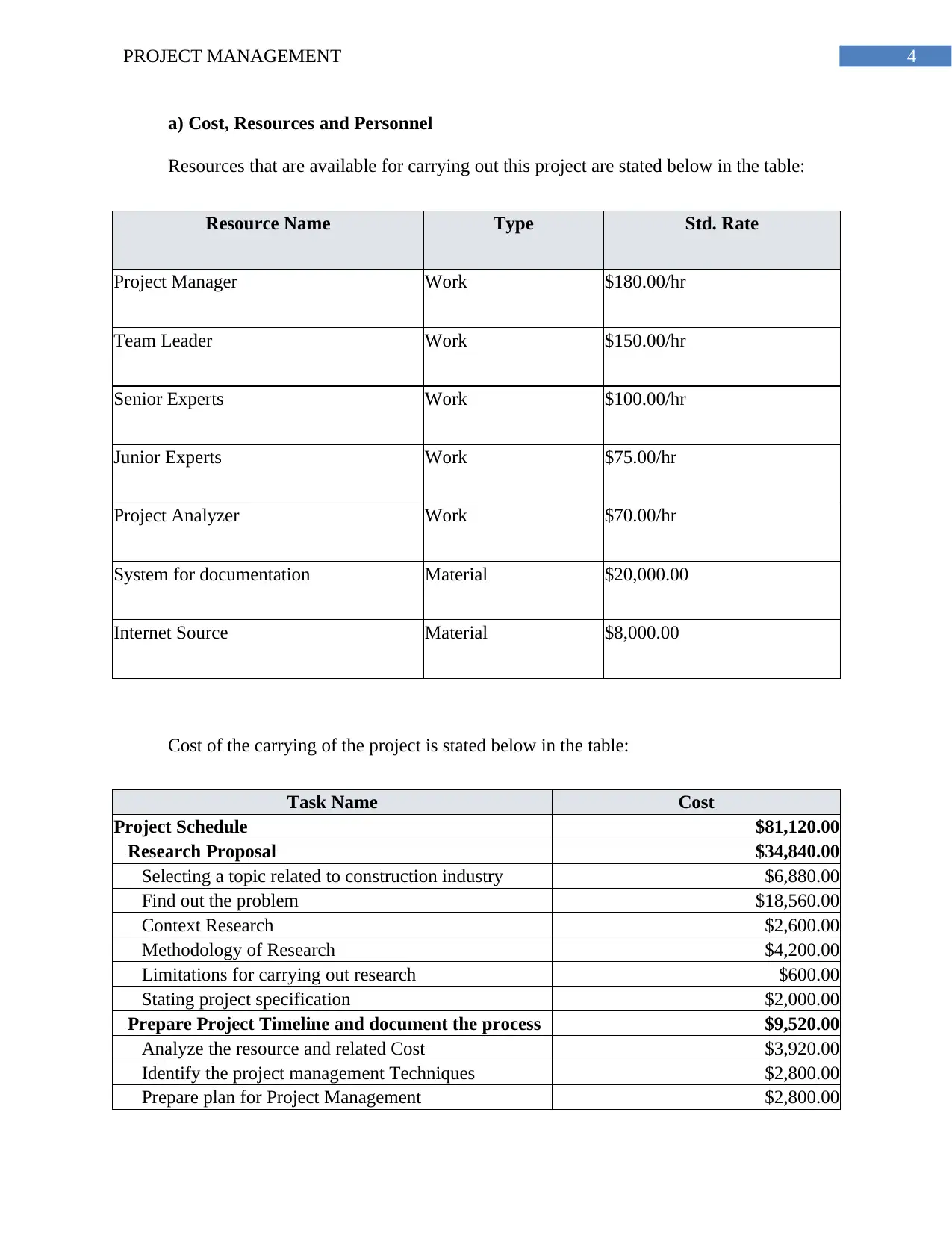
4PROJECT MANAGEMENT
a) Cost, Resources and Personnel
Resources that are available for carrying out this project are stated below in the table:
Resource Name Type Std. Rate
Project Manager Work $180.00/hr
Team Leader Work $150.00/hr
Senior Experts Work $100.00/hr
Junior Experts Work $75.00/hr
Project Analyzer Work $70.00/hr
System for documentation Material $20,000.00
Internet Source Material $8,000.00
Cost of the carrying of the project is stated below in the table:
Task Name Cost
Project Schedule $81,120.00
Research Proposal $34,840.00
Selecting a topic related to construction industry $6,880.00
Find out the problem $18,560.00
Context Research $2,600.00
Methodology of Research $4,200.00
Limitations for carrying out research $600.00
Stating project specification $2,000.00
Prepare Project Timeline and document the process $9,520.00
Analyze the resource and related Cost $3,920.00
Identify the project management Techniques $2,800.00
Prepare plan for Project Management $2,800.00
a) Cost, Resources and Personnel
Resources that are available for carrying out this project are stated below in the table:
Resource Name Type Std. Rate
Project Manager Work $180.00/hr
Team Leader Work $150.00/hr
Senior Experts Work $100.00/hr
Junior Experts Work $75.00/hr
Project Analyzer Work $70.00/hr
System for documentation Material $20,000.00
Internet Source Material $8,000.00
Cost of the carrying of the project is stated below in the table:
Task Name Cost
Project Schedule $81,120.00
Research Proposal $34,840.00
Selecting a topic related to construction industry $6,880.00
Find out the problem $18,560.00
Context Research $2,600.00
Methodology of Research $4,200.00
Limitations for carrying out research $600.00
Stating project specification $2,000.00
Prepare Project Timeline and document the process $9,520.00
Analyze the resource and related Cost $3,920.00
Identify the project management Techniques $2,800.00
Prepare plan for Project Management $2,800.00
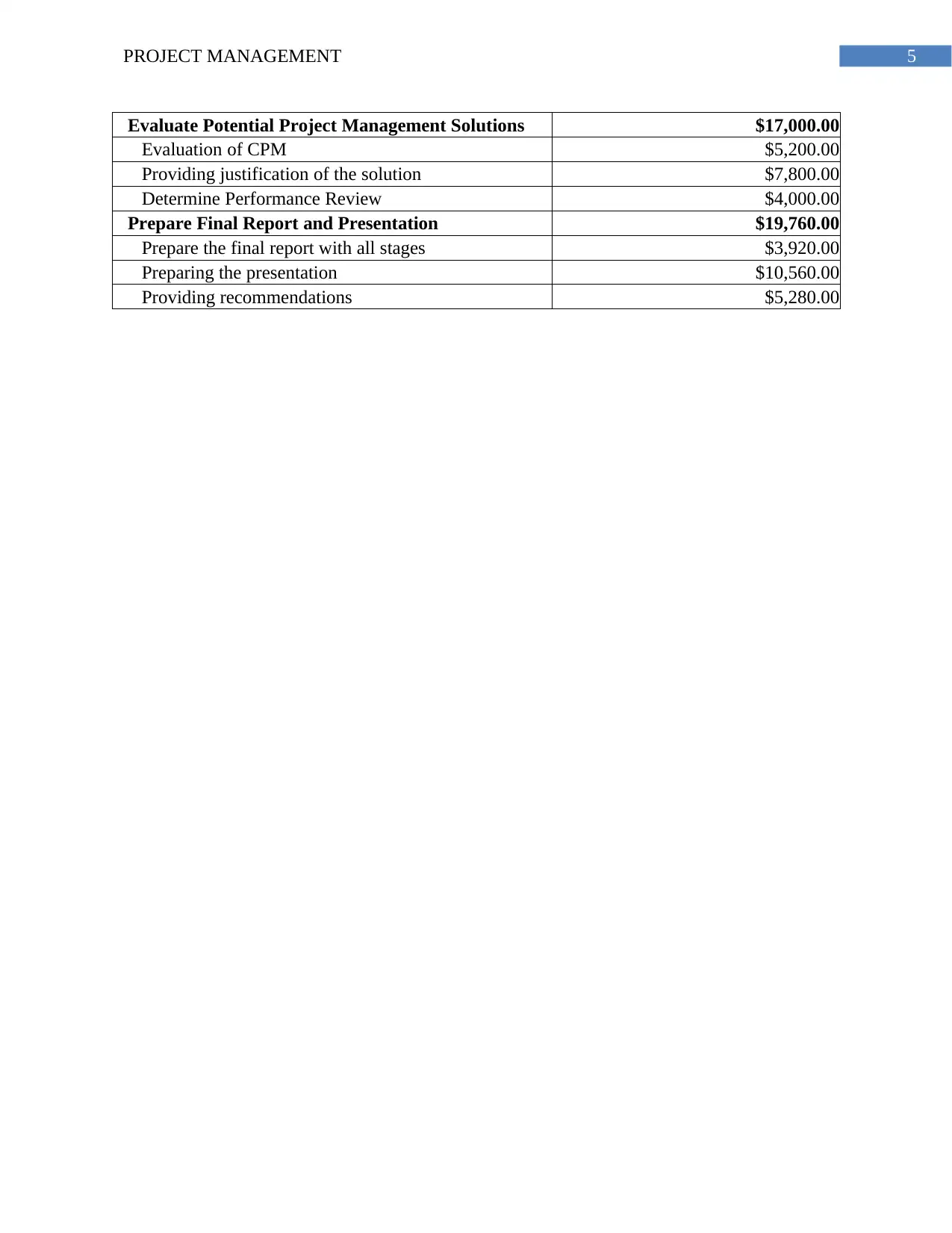
5PROJECT MANAGEMENT
Evaluate Potential Project Management Solutions $17,000.00
Evaluation of CPM $5,200.00
Providing justification of the solution $7,800.00
Determine Performance Review $4,000.00
Prepare Final Report and Presentation $19,760.00
Prepare the final report with all stages $3,920.00
Preparing the presentation $10,560.00
Providing recommendations $5,280.00
Evaluate Potential Project Management Solutions $17,000.00
Evaluation of CPM $5,200.00
Providing justification of the solution $7,800.00
Determine Performance Review $4,000.00
Prepare Final Report and Presentation $19,760.00
Prepare the final report with all stages $3,920.00
Preparing the presentation $10,560.00
Providing recommendations $5,280.00
⊘ This is a preview!⊘
Do you want full access?
Subscribe today to unlock all pages.

Trusted by 1+ million students worldwide
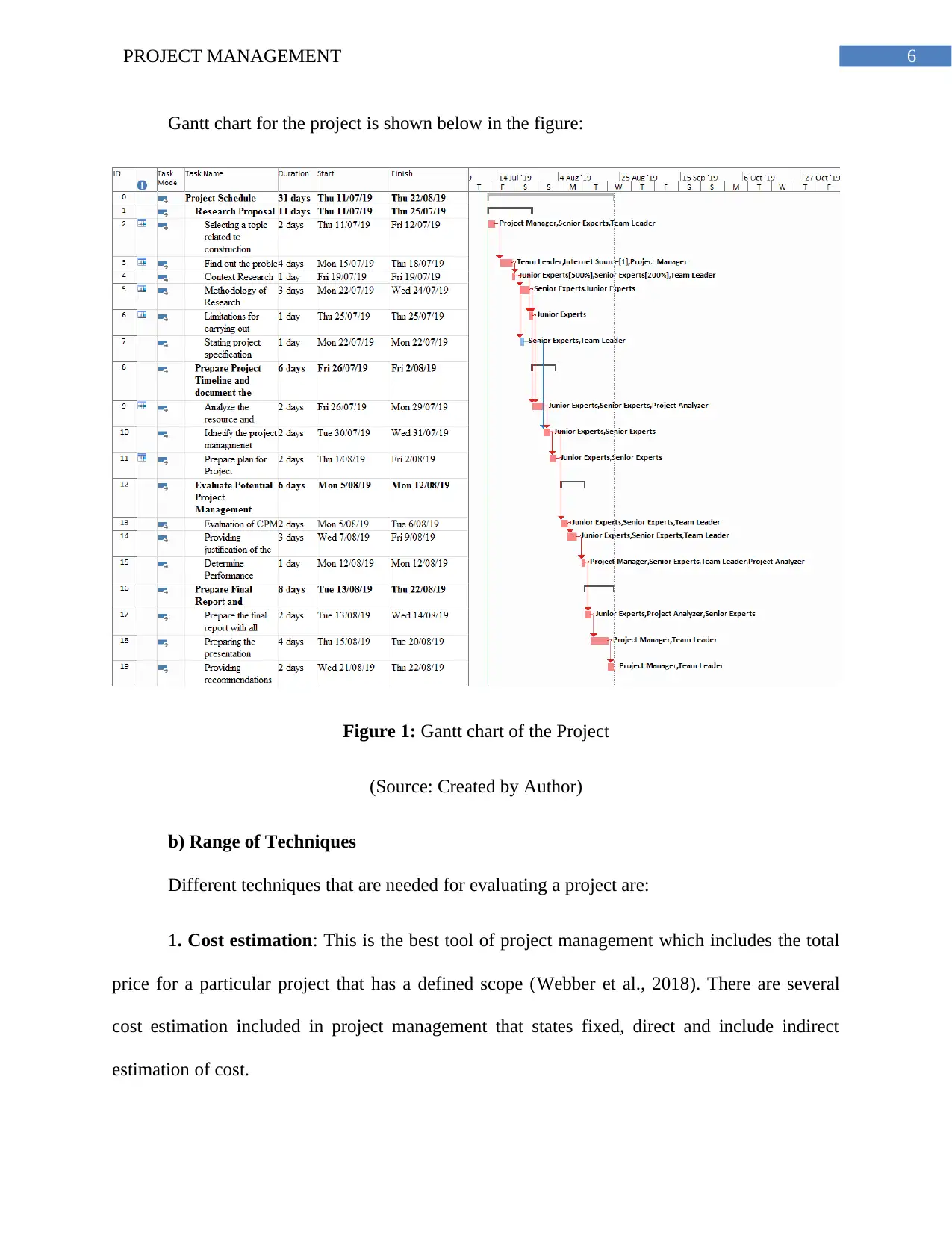
6PROJECT MANAGEMENT
Gantt chart for the project is shown below in the figure:
Figure 1: Gantt chart of the Project
(Source: Created by Author)
b) Range of Techniques
Different techniques that are needed for evaluating a project are:
1. Cost estimation: This is the best tool of project management which includes the total
price for a particular project that has a defined scope (Webber et al., 2018). There are several
cost estimation included in project management that states fixed, direct and include indirect
estimation of cost.
Gantt chart for the project is shown below in the figure:
Figure 1: Gantt chart of the Project
(Source: Created by Author)
b) Range of Techniques
Different techniques that are needed for evaluating a project are:
1. Cost estimation: This is the best tool of project management which includes the total
price for a particular project that has a defined scope (Webber et al., 2018). There are several
cost estimation included in project management that states fixed, direct and include indirect
estimation of cost.
Paraphrase This Document
Need a fresh take? Get an instant paraphrase of this document with our AI Paraphraser
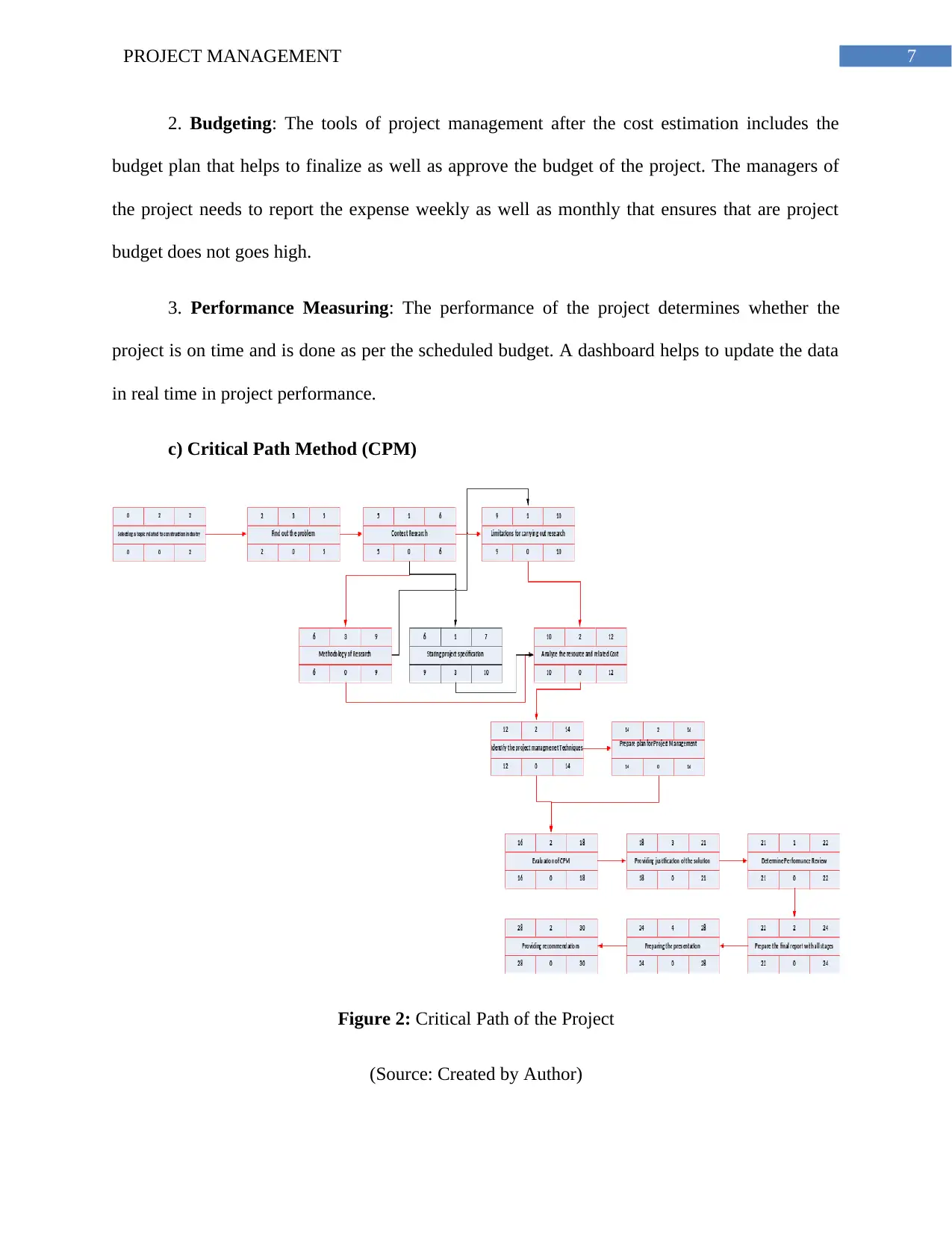
7PROJECT MANAGEMENT
2. Budgeting: The tools of project management after the cost estimation includes the
budget plan that helps to finalize as well as approve the budget of the project. The managers of
the project needs to report the expense weekly as well as monthly that ensures that are project
budget does not goes high.
3. Performance Measuring: The performance of the project determines whether the
project is on time and is done as per the scheduled budget. A dashboard helps to update the data
in real time in project performance.
c) Critical Path Method (CPM)
Figure 2: Critical Path of the Project
(Source: Created by Author)
2. Budgeting: The tools of project management after the cost estimation includes the
budget plan that helps to finalize as well as approve the budget of the project. The managers of
the project needs to report the expense weekly as well as monthly that ensures that are project
budget does not goes high.
3. Performance Measuring: The performance of the project determines whether the
project is on time and is done as per the scheduled budget. A dashboard helps to update the data
in real time in project performance.
c) Critical Path Method (CPM)
Figure 2: Critical Path of the Project
(Source: Created by Author)
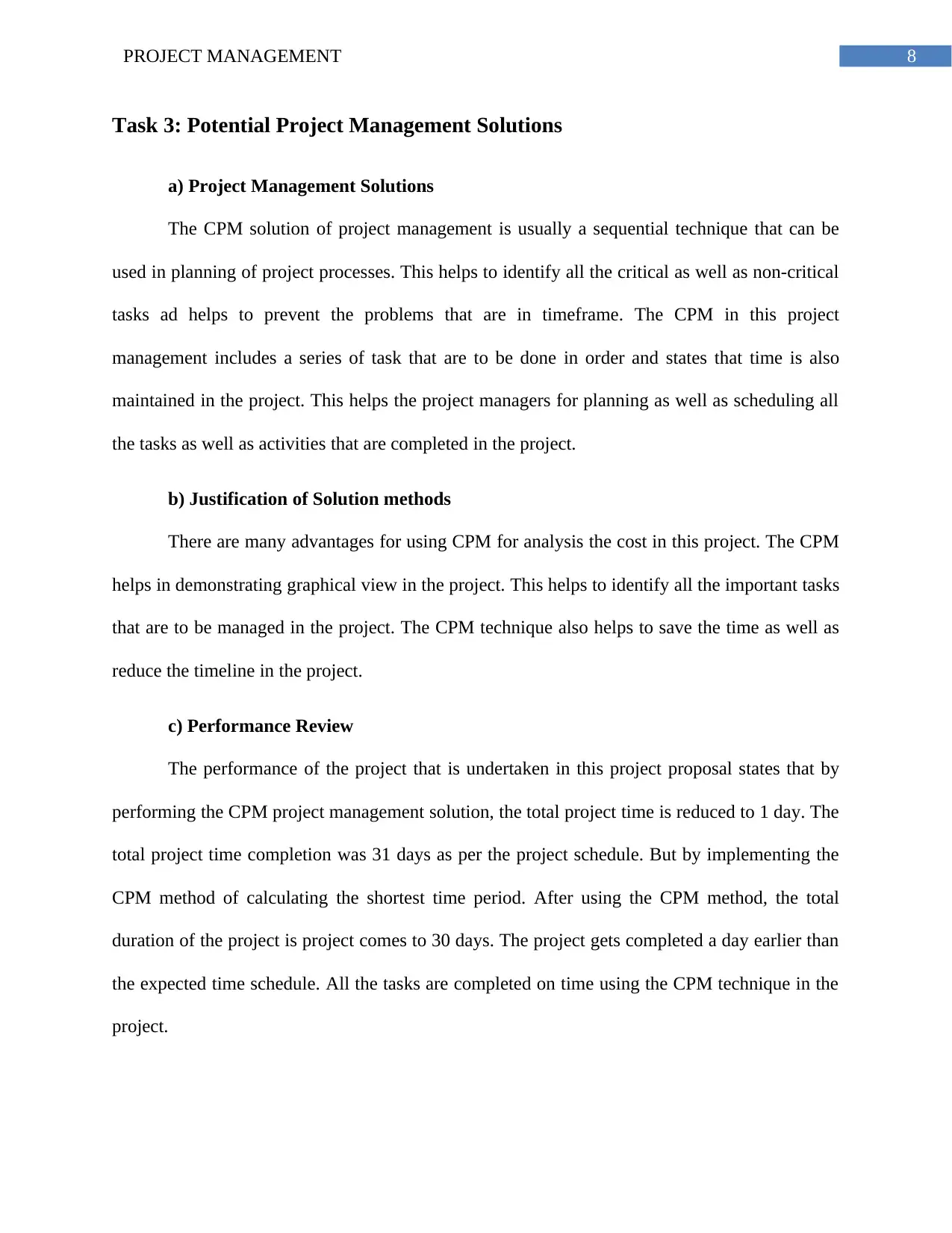
8PROJECT MANAGEMENT
Task 3: Potential Project Management Solutions
a) Project Management Solutions
The CPM solution of project management is usually a sequential technique that can be
used in planning of project processes. This helps to identify all the critical as well as non-critical
tasks ad helps to prevent the problems that are in timeframe. The CPM in this project
management includes a series of task that are to be done in order and states that time is also
maintained in the project. This helps the project managers for planning as well as scheduling all
the tasks as well as activities that are completed in the project.
b) Justification of Solution methods
There are many advantages for using CPM for analysis the cost in this project. The CPM
helps in demonstrating graphical view in the project. This helps to identify all the important tasks
that are to be managed in the project. The CPM technique also helps to save the time as well as
reduce the timeline in the project.
c) Performance Review
The performance of the project that is undertaken in this project proposal states that by
performing the CPM project management solution, the total project time is reduced to 1 day. The
total project time completion was 31 days as per the project schedule. But by implementing the
CPM method of calculating the shortest time period. After using the CPM method, the total
duration of the project is project comes to 30 days. The project gets completed a day earlier than
the expected time schedule. All the tasks are completed on time using the CPM technique in the
project.
Task 3: Potential Project Management Solutions
a) Project Management Solutions
The CPM solution of project management is usually a sequential technique that can be
used in planning of project processes. This helps to identify all the critical as well as non-critical
tasks ad helps to prevent the problems that are in timeframe. The CPM in this project
management includes a series of task that are to be done in order and states that time is also
maintained in the project. This helps the project managers for planning as well as scheduling all
the tasks as well as activities that are completed in the project.
b) Justification of Solution methods
There are many advantages for using CPM for analysis the cost in this project. The CPM
helps in demonstrating graphical view in the project. This helps to identify all the important tasks
that are to be managed in the project. The CPM technique also helps to save the time as well as
reduce the timeline in the project.
c) Performance Review
The performance of the project that is undertaken in this project proposal states that by
performing the CPM project management solution, the total project time is reduced to 1 day. The
total project time completion was 31 days as per the project schedule. But by implementing the
CPM method of calculating the shortest time period. After using the CPM method, the total
duration of the project is project comes to 30 days. The project gets completed a day earlier than
the expected time schedule. All the tasks are completed on time using the CPM technique in the
project.
⊘ This is a preview!⊘
Do you want full access?
Subscribe today to unlock all pages.

Trusted by 1+ million students worldwide
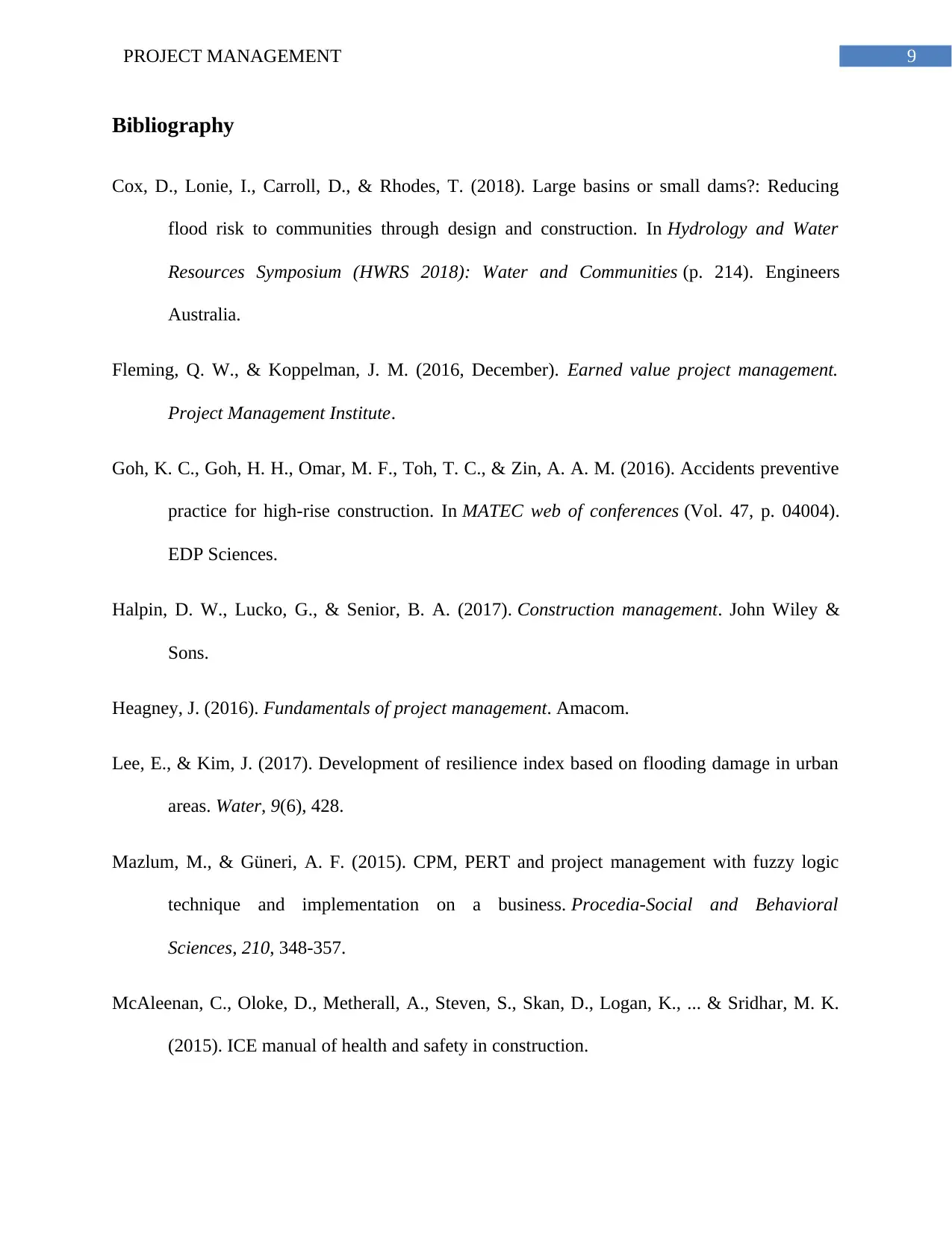
9PROJECT MANAGEMENT
Bibliography
Cox, D., Lonie, I., Carroll, D., & Rhodes, T. (2018). Large basins or small dams?: Reducing
flood risk to communities through design and construction. In Hydrology and Water
Resources Symposium (HWRS 2018): Water and Communities (p. 214). Engineers
Australia.
Fleming, Q. W., & Koppelman, J. M. (2016, December). Earned value project management.
Project Management Institute.
Goh, K. C., Goh, H. H., Omar, M. F., Toh, T. C., & Zin, A. A. M. (2016). Accidents preventive
practice for high-rise construction. In MATEC web of conferences (Vol. 47, p. 04004).
EDP Sciences.
Halpin, D. W., Lucko, G., & Senior, B. A. (2017). Construction management. John Wiley &
Sons.
Heagney, J. (2016). Fundamentals of project management. Amacom.
Lee, E., & Kim, J. (2017). Development of resilience index based on flooding damage in urban
areas. Water, 9(6), 428.
Mazlum, M., & Güneri, A. F. (2015). CPM, PERT and project management with fuzzy logic
technique and implementation on a business. Procedia-Social and Behavioral
Sciences, 210, 348-357.
McAleenan, C., Oloke, D., Metherall, A., Steven, S., Skan, D., Logan, K., ... & Sridhar, M. K.
(2015). ICE manual of health and safety in construction.
Bibliography
Cox, D., Lonie, I., Carroll, D., & Rhodes, T. (2018). Large basins or small dams?: Reducing
flood risk to communities through design and construction. In Hydrology and Water
Resources Symposium (HWRS 2018): Water and Communities (p. 214). Engineers
Australia.
Fleming, Q. W., & Koppelman, J. M. (2016, December). Earned value project management.
Project Management Institute.
Goh, K. C., Goh, H. H., Omar, M. F., Toh, T. C., & Zin, A. A. M. (2016). Accidents preventive
practice for high-rise construction. In MATEC web of conferences (Vol. 47, p. 04004).
EDP Sciences.
Halpin, D. W., Lucko, G., & Senior, B. A. (2017). Construction management. John Wiley &
Sons.
Heagney, J. (2016). Fundamentals of project management. Amacom.
Lee, E., & Kim, J. (2017). Development of resilience index based on flooding damage in urban
areas. Water, 9(6), 428.
Mazlum, M., & Güneri, A. F. (2015). CPM, PERT and project management with fuzzy logic
technique and implementation on a business. Procedia-Social and Behavioral
Sciences, 210, 348-357.
McAleenan, C., Oloke, D., Metherall, A., Steven, S., Skan, D., Logan, K., ... & Sridhar, M. K.
(2015). ICE manual of health and safety in construction.
Paraphrase This Document
Need a fresh take? Get an instant paraphrase of this document with our AI Paraphraser
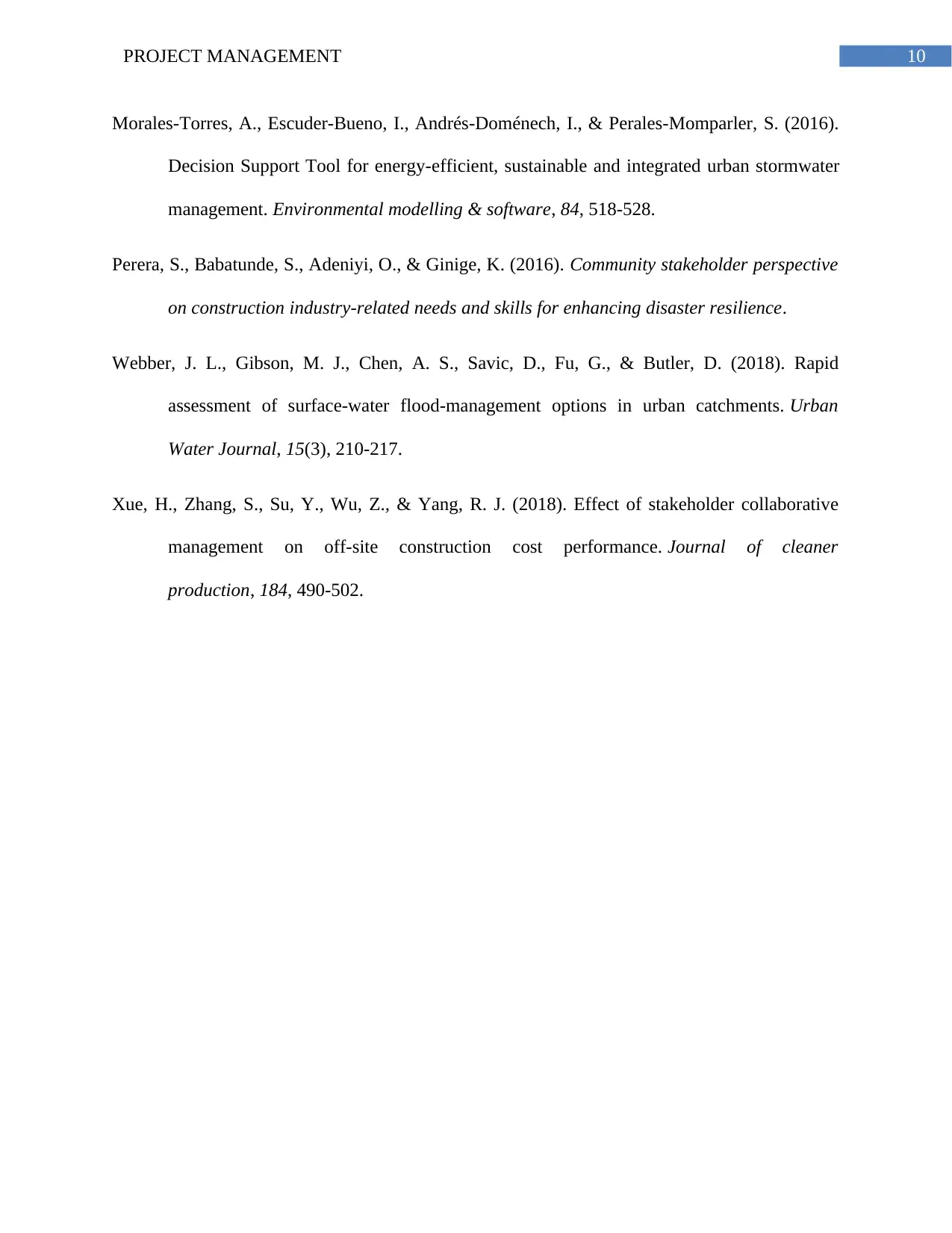
10PROJECT MANAGEMENT
Morales-Torres, A., Escuder-Bueno, I., Andrés-Doménech, I., & Perales-Momparler, S. (2016).
Decision Support Tool for energy-efficient, sustainable and integrated urban stormwater
management. Environmental modelling & software, 84, 518-528.
Perera, S., Babatunde, S., Adeniyi, O., & Ginige, K. (2016). Community stakeholder perspective
on construction industry-related needs and skills for enhancing disaster resilience.
Webber, J. L., Gibson, M. J., Chen, A. S., Savic, D., Fu, G., & Butler, D. (2018). Rapid
assessment of surface-water flood-management options in urban catchments. Urban
Water Journal, 15(3), 210-217.
Xue, H., Zhang, S., Su, Y., Wu, Z., & Yang, R. J. (2018). Effect of stakeholder collaborative
management on off-site construction cost performance. Journal of cleaner
production, 184, 490-502.
Morales-Torres, A., Escuder-Bueno, I., Andrés-Doménech, I., & Perales-Momparler, S. (2016).
Decision Support Tool for energy-efficient, sustainable and integrated urban stormwater
management. Environmental modelling & software, 84, 518-528.
Perera, S., Babatunde, S., Adeniyi, O., & Ginige, K. (2016). Community stakeholder perspective
on construction industry-related needs and skills for enhancing disaster resilience.
Webber, J. L., Gibson, M. J., Chen, A. S., Savic, D., Fu, G., & Butler, D. (2018). Rapid
assessment of surface-water flood-management options in urban catchments. Urban
Water Journal, 15(3), 210-217.
Xue, H., Zhang, S., Su, Y., Wu, Z., & Yang, R. J. (2018). Effect of stakeholder collaborative
management on off-site construction cost performance. Journal of cleaner
production, 184, 490-502.
1 out of 11
Related Documents
Your All-in-One AI-Powered Toolkit for Academic Success.
+13062052269
info@desklib.com
Available 24*7 on WhatsApp / Email
![[object Object]](/_next/static/media/star-bottom.7253800d.svg)
Unlock your academic potential
Copyright © 2020–2025 A2Z Services. All Rights Reserved. Developed and managed by ZUCOL.



